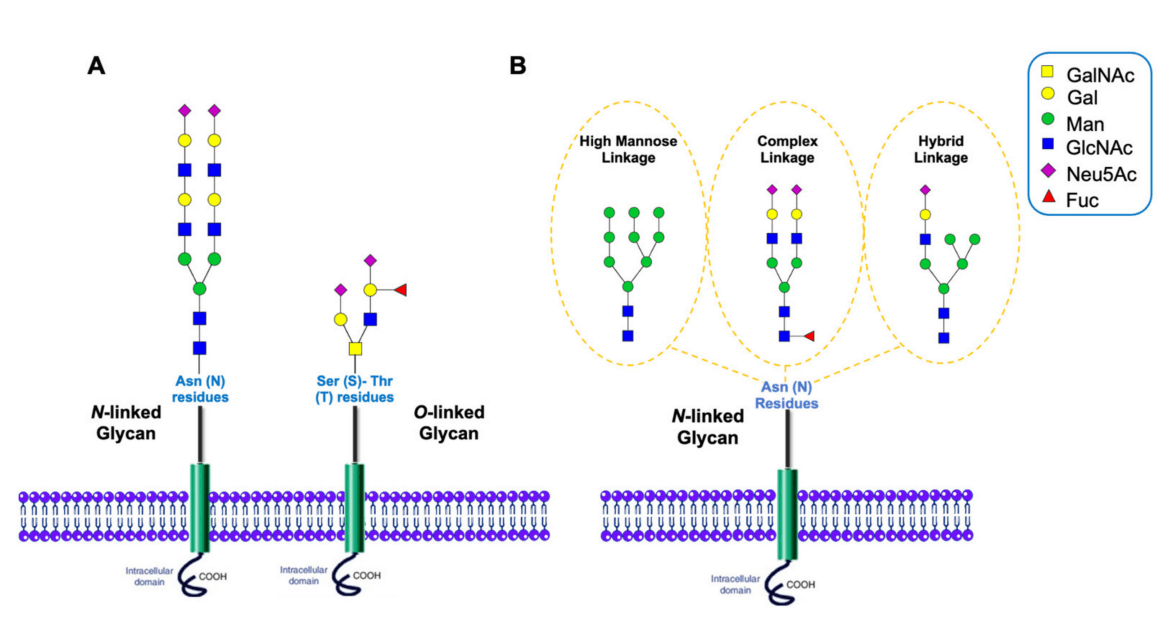Glycan in Neurology and Psychiatry
Glycans attached to proteins or sphingolipids are ubiquitous in the biological system. They are involved in many important processes, such as metastasis, inflammation, immunological response, and bacterial and viral infection. Biological functions of glycans as well as biomedical applications of glycoconjugates have become hot spots of subjects of scientists. As a first-class provider in the antibody market, Creative Biolabs pays attention to the neurology and psychiatry field for sensitive and accessible antibody products, along with advanced techniques for glycoprotein analysis services.
Major Glycan Structure of Epitope in the Developing Brain
Glycosylation is a major protein modification. There is a certain glycan epitope that has only been observed in a limited number of proteins. Among them, Lewis X is highly expressed in the early stage of a developing brain, and its epitope consists of a trisaccharide (Galβ1 4 (Fucα1-3) GlcNAc). Investigators tried to identify the main glycoprotein carrying the Lewis X epitope and the scaffolding glycan structure in developing brains. The results showed that the Lewis X epitope was mostly expressed on phosphacan/RPTPβ. Also, the expression of Lewis X was markedly decreased in POMGnT1 gene-deficient mice, revealing that a major scaffolding glycan presenting Lewis X is the O-mannose-linked glycans.
Pathogenic Autoantibodies Targeted Neuronal Glycans
Numerous diseases are associated with circulating antibodies directed against specific glycans enriched in nervous systems, resulting in autoimmune neural damage. And these antibodies can be generated by distinct pathogenic mechanisms. Firstly, patients with benign or malignant B-cell neoplasms release monoclonal IgA or IgM antibodies that are specific for either ganglioside or more often for sulfated glucuronosyl glycans (HNK-1 epitope). The second is to initiate an immune reaction to molecular mimicry of neural ganglioside structures by the lip-oligosaccharides from bacteria. Following an intestinal infection, circulating cross-reacting antibodies against gangliosides (e.g. GM1 and GQ1b) appear in the plasma, related to the symptom of peripheral demyelinating neuropathy. The third case is a human-induced disease arising from attempts to treat stroke patients using intravenous injections of mixed bovine brain gangliosides.
Here, reporters found that a subgroup of populations with chronic inflammatory demyelinating polyradiculoneuropathy (CIDP) shows autoantibodies to contactin. They mapped the molecular determinants of contactin targeted by autoantibodies. In 3 patients, immunoreactivities were directed against the Ig domains of contactin and were dependent on N-glycans.
 Fig.1 A depiction of the nomenclature, topology, and glycosylation patterns of N- and O-glycans.1, 2
Fig.1 A depiction of the nomenclature, topology, and glycosylation patterns of N- and O-glycans.1, 2
Glycans in Alzheimer's Disease (AD)
AD is a neurodegenerative disorder of humans characterized by the loss of patients' memory and cognitive ability. Its mechanism is not completely clear and it is ultimately diagnosed by the postmortem histological examination of brain tissues. Several types of glycans have been involved in the histopathogenesis of lesions, for instance, O-GlcNAc and heparan sulfate (HS) glycosaminoglycans.
Glycobiology technology demonstrates that glycan modifications of AD-related molecules are profoundly implicated in the onset and progression of this disease. Research summarized the roles of N-glycans in the AD pathogenesis and development, particularly in key AD-related molecules, including amyloid precursor proteins (APP), α, β, γ-secretases, and tau proteins.
Currently, the effect of polysaccharides from traditional Chinese medicine (TCM) on anti-AD has gained great progress and gained increasing attention in recent years. Notably, TCM-polysaccharides have the advantage over treatment focusing on a single target and can function by targeting amyloid β-peptide (Aβ), tau protein, cholinergic neurotransmitter, calcium channels, and many others.
Additionally, chitosan (CTS), chitooligosaccharide (COS) and their derivatives derived from exoskeletons of crustaceans and cell walls of fungi have been reported to show neuroprotective and antioxidative effects, matrix metalloproteinase inhibition, anti-inflammatory, and anti-HIV properties.
References:
- Kobeissy, Firas, et al. "Glycomic and glycoproteomic techniques in neurodegenerative disorders and neurotrauma: towards personalized markers." Cells 11.3 (2022): 581.
- Distributed under Open Access license CC BY 4.0, without modification.
